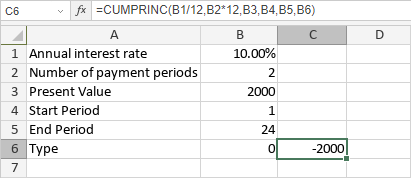- Home
- CUMPRINC function
CUMPRINC function
The CUMPRINC function is one of the financial functions. It is used to calculate the cumulative principal paid on an investment between two periods based on a specified interest rate and a constant payment schedule.
Syntax
CUMPRINC(rate, nper, pv, start_period, end_period, type)
The CUMPRINC function has the following arguments:
| Argument | Description |
|---|---|
| rate | The interest rate for the investment. |
| nper | A number of payments. |
| pv | A present value of the payments. |
| start_period | The first period included into the calculation. The value must be from 1 to nper. |
| end_period | The last period included into the calculation. The value must be from 1 to nper. |
| type | A period when the payments are due. If it is set to 0 or omitted, the function will assume the payments to be due at the end of the period. If type is set to 1, the payments are due at the beginning of the period. |
Notes
Cash paid out (such as deposits to savings) is represented by negative numbers; cash received (such as dividend checks) is represented by positive numbers. Units for rate and nper must be consistent: use N%/12 for rate and N*12 for nper in case of monthly payments, N%/4 for rate and N*4 for nper in case of quarterly payments, N% for rate and N for nper in case of annual payments.
How to apply the CUMPRINC function.
Examples
The figure below displays the result returned by the CUMPRINC function.
